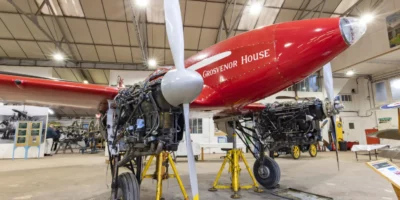Technology, according to the OED, is ‘the study or use of the mechanical arts and applied sciences’. Modern parlance has added a spin, and for most people it suggests something new, about which we probably need to learn. Or not… Lift the bonnet of any modern car and all you see is a large amount of plastic – and you can spend a fair while looking for a dipstick, only to find there isn’t one. Technology has taken care of all these things, and not just the operation, but the need to know, in order to operate safely. That wasn’t always the case, and at one time if you didn’t know how to clean the points with your wife’s emery board, you weren’t getting home.
“My quest to eliminate radio interference has uncovered more increasingly arcane knowledge”
That’s still true of the aeroplanes most of us fly, and yes I know there are reasons. The PPL syllabus still includes a section on ‘The aeroplane, technical’, while there is nothing similar in requirements for a DVLA licence. There probably should be, as in some countries.
Aircraft are still maintenance-intensive mainly because the technology dates from a period when everything was. But there is a small band of dedicated professionals (and amateurs) who know what needs to be done, and when, and because there are common factors – Lycoming, Continental, Rotax, riveted aluminium – the generic knowledge base is maintained. As I have mentioned more than a few times though, that knowledge begins to disappear when it’s specific to only a few types – Gipsy, Blackburn, Walter, Menasco, Pobjoy… Some of these were made in reasonable numbers – in aviation terms – but that was a while ago, and because there are now only a tiny number still in service, many of the people who knew the essential stuff have retired, along with the knowledge. The Blackburn maintenance manual includes a sentence about cylinder base nuts, stating ‘tighten well and evenly…’, no value was written down either because those who needed to know, already knew.
The magneto on my Cirrus Major was made by British Thomson Houston, better known as BTH. They were once common on British-made cars and motorcycles as well as aircraft, and unlike the normal American equivalent, they incorporate a rotating coil inside a large magnet. This means that each successive spark has a different polarity, one goes from the central electrode to earth, the next does the opposite. Why is that relevant ? Because one direction makes the plug gap open up more readily. It’s apparently something that Lodge the plug makers knew and which they tried to develop. The rotating coil also makes four sparks of diminishing intensity, and I’m told that that can stress the coil if it senses any resistance in the lead. Like the one you fit when you’re trying to cure radio interference… When the RAF were operating Chipmunks – which are fitted with a Gipsy Major which is fitted with a BTH magneto – and which it continued to use until fairly recently, it apparently complained to Lucas (who had since purchased BTH). Lucas said it would wind the coil in a different way to address the problem. Lost knowledge? Did nobody complain before? Did they not have 8.33 radios to contend with. It’s all right, I know the answer to that one.
I was also reminded by David Beale, constructor of the magnificent Mew Gull featured on p26, that it is really important if you are using automotive plugs on your Gipsy (or Blackburn), to close down the plug gaps to no more than 12 thou. Automotive ones come ready gapped at 25 thou, plus they will open up for reasons already mentioned. The magneto sees that as an obstruction, and self-destructs its coil in protest. Fascinating stuff for a detail obsessive, but did I need to know this before ? Not until I tried to use a BTH in an aeroplane equipped with a new specification radio. Interference from the plugs is nothing new, and it’s part of the reason that modern cars have resistor plugs, caps and leads. They no longer have BTH magnetos.
I also learned recently that the service instructions for the nine-cylinder Continental R670 and R975 radial engines used in the Sherman tank in the 1930s, included a requirement to gap the plugs at 13 thou, whereas aircraft use required 16 to 18 thou. Why? I’m guessing because a tank was equipped with a radio as a military operational necessity, whereas aircraft of the period didn’t usually have one. My quest to eliminate interference has uncovered more increasingly arcane knowledge, including one from a reader who recounted how he tackled the problem of earth loops for the radio in his Austin A35. I shall try some of his tips… Also, the one that suggested a more effective ground plane. That’s usually the aluminium sheet under the aerial, which you need in a wooden aeroplane apparently to reflect the radio waves and make a single pole more like a vintage TV aerial. It actually forms part of the aerial itself, and is a great deal larger in an aircraft with a metal fuselage, but non-existent in a wooden one. I now know that instead of trying to install a yet larger sheet of aluminium in the back of my Messenger, I can use several lengths of wire, equalling multiples of the aerial length, spread like a spider’s legs. I’ll do that, sounds a lot easier.
I’m sure there are professionals who already know this stuff, because it’s relevant to modern communication, but the amateurs who know more than most, are the CB lot. There’s one who parks up the road with a huge (monopole) aerial on the roof. I’ll ask if he uses a separate ground plane, or whether it’s just the Citroen Picasso…
Vintage aircraft and cars make Mark particularly happy.
[email protected]







